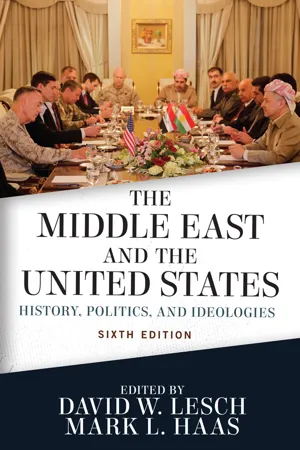US involvement in the Middle East has spanned the breadth of this country’s existence, beginning most dramatically with President Thomas Jefferson’s administration, which tried to stop pirating by the North African (or Barbary) provinces of the Ottoman Empire in the early 1800s. This was a war to ensure freedom of navigation on the high seas, which was essential for US trade, as the new republic no longer enjoyed British naval protection. Aside from this early encounter, US interaction with and interest in the Middle East during the nineteenth century was limited to the private activities of missionaries and merchants. In the twentieth century, however, World War I propelled the United States onto the world stage—and into European politics—in a role it had neither sought nor experienced before. As the war was winding down, the United States quickly developed an interest in the disposition of the Middle East provinces of the defeated Ottoman Empire. The result was Washington’s first significant official foray into the region: the King-Crane Commission was sent to Syria, Palestine, Lebanon, and Anatolia to inform American policy on the future of the region. Nonetheless, no US administration gave the region a high priority during the interwar years (1918–1939), although there was some interest in the growing involvement of multinational oil companies in the Middle East.
The strategic value of the region became clear in World War II, when, in 1942 and 1943, Anglo-American forces attacked and defeated German-Italian forces in the North African campaign. Soon the realization that the reconstruction of Europe and Japan—as well as the postwar economic boom in the United States—would become more and more dependent on Middle East oil (more than two-thirds of the world’s known reserves) boosted the policy significance of the region in the eyes of Washington’s policymakers. Moreover, the strategic value of the Middle East became linked to the emerging Cold War between the United States and the Soviet Union. The United States came to believe that it was the only nation that could successfully prevent Moscow from extending its influence in the region in the wake of the weakened British and French imperial positions. As a result, the Middle East became a policy priority for post–World War II administrations. The emergence of the state of Israel in 1948 reinforced US interest in the Middle East, but this event also complicated Washington’s relations with, and objectives toward, the Arab world, as Arabs increasingly perceived US and Israeli interests as being one and the same. Complication and complexity came to define the US–Middle East relationship in the aftermath of World War II and the initial stages of the Cold War, especially as it became intertwined with the decolonization process, Arab nationalism and state building, and the emerging Arab-Israeli conflict.
Part I of this book, “The US Enters the Middle East,” examines some entry points into the region since the beginning of the republic. In Chapter 1, Robert Allison looks back at America’s views and interactions with the Middle East during the earliest years of the republic, showing how many Americans held a distorted image of the region and Islam and how these misperceptions contributed to the Tripolitan War. In the post–9/11 world in which we live, it seems, as Allison poignantly observes, that some perceptions have not changed all that much.
Next, James Gelvin examines the King-Crane Commission, which emanated from the idealistic intentions of President Woodrow Wilson’s Fourteen Points, enunciated near the end of World War I—particularly that of self-determination for subject peoples—and was ostensibly created to assess the wishes of the native population in Syria regarding postwar independence. The commission did not quite fit the reality of European politics—or, for that matter, American politics—and as Gelvin points out, it was not as idealistic as it seemed, since it simply reflected and transferred democratic elitism. After examining the King-Crane Commission from the Syrian perspective, Gelvin concludes that the commission actually established a pattern for subsequent US encounters with nationalism and state building in the Middle East that had unforeseen and often deleterious results for both the United States and the region.
The great divide of World War II awakened policymakers to the necessity of a more active and goal-oriented foreign policy commensurate with the onset of the Cold War and related regional issues. Yet there was a strong desire rooted in the American heritage to portray the United States as anything but a second-generation imperialist trying to trade places with the Europeans. This schizophrenia in US diplomacy toward what was then called the Third World in the immediate post–World War II period can particularly be seen in the Muhammad Mussadiq crisis of 1953, when covert efforts primarily engineered by the United States succeeded in overthrowing the popularly elected Iranian prime minister. At the time, Washington and London thought Mussadiq would tilt Iran toward the Soviet Union, which was viewed as an unacceptable strategic setback that could lead to a potentially disastrous superpower confrontation. The Mussadiq crisis reveals how the United States began almost instinctively to follow in the footsteps of British imperialism, demonstrating a preference for the status quo rather than the forces of change. This episode is examined in Chapter 3 by Mark Gasiorowski, who details—and is critical of—US policy in the matter. In an insert in the Gasiorowski chapter, Sir Sam Falle, a high-level official in the British embassy in Tehran at the time of the crisis, provides an on-the-ground viewpoint, and he maintains that US and British actions were correct, illuminating the at-times differing perspectives of historians looking backward and diplomats living forward.
Peter Hahn closes this section by offering a description of this transitional stage in US diplomacy toward the Middle East as strategic necessities of the Cold War became the paramount consideration. In Chapter 4, he examines Washington’s relationship with Egypt from the last stage of the King Farouk regime to the early Nasserist period, ending with the Suez crisis and war in 1956.
